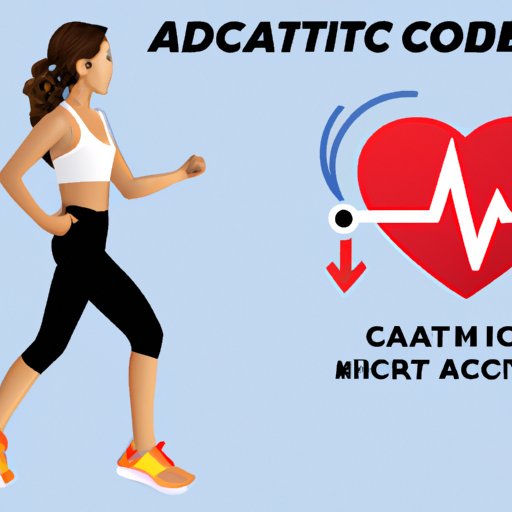Introduction
Aerobic exercise is any type of physical activity that increases your heart rate and breathing, such as walking, running, swimming, biking, or dancing. It is an important component of overall health and wellness, and has been linked to a variety of positive health outcomes, including improved cardiovascular health. Cardiovascular diseases are a group of conditions affecting the heart and blood vessels, including coronary artery disease, stroke, and hypertension. In this article, we will explore how aerobic exercise can help prevent cardiovascular diseases.

Physical Benefits of Aerobic Exercise for Cardiovascular Health
Regular aerobic exercise has been shown to have a number of positive effects on the body’s cardiovascular system. Studies have found that aerobic exercise can improve heart function, reduce risk factors for cardiovascular diseases, and improve blood pressure.
Aerobic exercise helps strengthen the heart muscle, making it more efficient at pumping blood throughout the body. This increases the supply of oxygen-rich blood to the muscles, which can help improve performance during exercise and other physical activities. Regular aerobic exercise also helps reduce risk factors for cardiovascular diseases, such as high cholesterol and triglyceride levels, obesity, and diabetes.
In addition to improving heart function, aerobic exercise can also help improve blood pressure. Studies have found that regular aerobic exercise can reduce both systolic (upper) and diastolic (lower) blood pressure readings. This is due to the fact that aerobic exercise helps increase the diameter of the blood vessels, allowing for easier blood flow.
Role of Aerobic Exercise in Improving Cholesterol Levels
Cholesterol is a waxy substance found in the bloodstream that plays an important role in the body’s metabolism. High cholesterol levels can lead to an increased risk of cardiovascular diseases, such as coronary artery disease and stroke. Regular aerobic exercise can help reduce cholesterol levels by increasing the amount of “good” cholesterol (HDL) and reducing the amount of “bad” cholesterol (LDL).
Aerobic exercise helps increase HDL cholesterol levels by stimulating the production of HDL particles by the liver. HDL cholesterol helps remove LDL cholesterol from the body, which can help reduce the risk of cardiovascular diseases. Regular aerobic exercise can also help reduce LDL cholesterol levels by helping the body break down and eliminate LDL particles.

Impact of Aerobic Exercise on Weight Management
Obesity is a major risk factor for a number of cardiovascular diseases, including coronary artery disease, stroke, and hypertension. Regular aerobic exercise can help reduce weight and body fat levels, which can help reduce the risk of developing these conditions. Aerobic exercise helps burn calories, which can lead to weight loss. It also helps increase lean muscle mass, which can help boost metabolism.
Weight loss can also help reduce the risk of developing type 2 diabetes. Studies have found that regular aerobic exercise can help improve insulin sensitivity and reduce blood sugar levels, which can help reduce the risk of developing type 2 diabetes.

Reduction of Inflammation with Aerobic Exercise
Inflammation is a natural response of the body to injury and infection, but it can also be a contributing factor to cardiovascular diseases. Regular aerobic exercise has been linked to a reduction in inflammation, due to the presence of antioxidants in the body. Antioxidants help neutralize free radicals, which can damage cells and lead to inflammation.
Regular aerobic exercise also helps reduce oxidative stress, which occurs when the body produces too many free radicals. Oxidative stress can increase inflammation and damage blood vessels, leading to an increased risk of cardiovascular diseases. Regular aerobic exercise can help reduce oxidative stress by helping to clear free radicals from the body.
Conclusion
In conclusion, regular aerobic exercise can help reduce the risk of developing cardiovascular diseases. It can help improve heart function, reduce risk factors, improve blood pressure, and reduce cholesterol levels. It can also help with weight management and reduce inflammation. For these reasons, it is important to incorporate aerobic exercise into your daily routine.
By engaging in regular aerobic exercise, you can help reduce your risk of developing cardiovascular diseases and improve your overall health and wellbeing. Be sure to talk to your doctor before starting any new exercise program to make sure it is safe for you. With the right approach, aerobic exercise can be a powerful tool for improving your cardiovascular health.
(Note: Is this article not meeting your expectations? Do you have knowledge or insights to share? Unlock new opportunities and expand your reach by joining our authors team. Click Registration to join us and share your expertise with our readers.)
